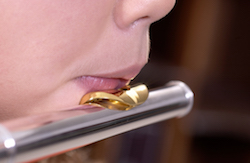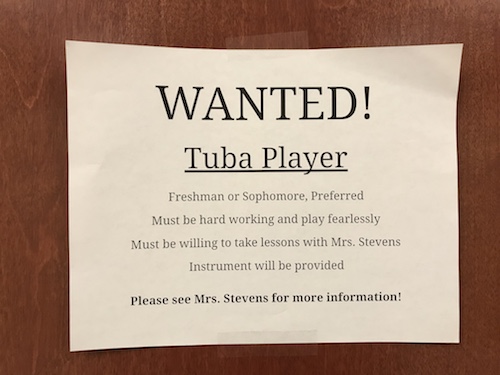Monday, March 26, 2018

Flute Headjoint
Tips/Reminders:
- Cover the end of the headjoint with the palm of the hand for a more pleasing tone
- Don't let the end of the headjoint dip downward; that will lead to an airy tone
- Keep the headjoint steady; no rolling in or out
- "Aim the air down at your feet" for the low pitch
- "Aim the air above your stand" for the high pitch
- Blowing "faster" air for the high pitch will lead to intonation/tone issues in upper octaves
- Blowing "slower" air for the low pitch will lead to weak low octave tone quality
- Once long tones and simple rhythms can be achieved on both low and high tones consistently, have the students practice switching between the two while playing those same simple rhythms
Clarinet Mouthpiece & Barrel
Tips/Reminders:
- Teach them to find the "Sweet Spot": Have them look at the mouthpiece from the side and find where the reed and mouthpiece meet in a V-shape. The teeth should be placed directly above that point on the mouthpiece to get maximum reed response. Most students don't take in enough mouthpiece, so this will likely produce a change for them.
- Hold the barrel with one hand and sit up straight
- Mouthpiece should be inserted at approximately a 30 degree angle (with some variance)
- If pitch is too high and pinched: more mouthpiece, lower jaw, firm corners, lower tongue
- If pitch is too low and "soggy": firm corners, raise tongue, harder reed (at times)
- Teach students to bend the pitch - start with sirens and progress to Remington-style exercises (e.g. play F#-F-F# | F#-E-F# | F#-Eb-F# | etc.)
- Once student is playing a strong F#, it's time to add articulations
- Keep jaw and embouchure steady while articulating to hold the pitch
Saxophone Mouthpiece & Barrel
Tips/Reminders:
- See "sweet spot" tip under in clarinet section
- Hold the mouthpiece with thumb and two fingers on the ligature
- Alto mouthpieces will form a 45 degree angle with the body, with tenor and bari flattening out more
- If pitch is too high and pinched - more mouthpiece, lower jaw, firm corners, lower tongue
- If pitch is too low and "soggy" - firm corners, raise tongue, harder reed (at times)
- Teach students to bend the pitch - start with sirens and progress to Remington-style exercises (e.g. play A-G#-A | A-G-A | A-F#-A | etc.)
- Once student is playing the correct pitch consistently, it's time to add articulations
- Keep jaw and embouchure steady while articulating to hold the pitch
Again, just a few minutes each day spent on these exercises will improve your woodwind section's tone quality, their confidence, and their intonation. They will not like the sounds they're making at first, but I promise you it will pay off, so stay the course! Good luck in trying this new venture! Shoot me an email and let me know how it goes for you.
 | Mike joined the PMC team as an Educational Representative in 2011, and has since traveled all over Missouri serving directors and their programs. He is a KC native and a graduate of Grandview High School, and holds Music Education Degrees from University of Missouri - Kansas City and Missouri State. He served as a band director in the Lee's Summit R-7 & Pleasant Hill R-3 School Districts where he taught band in grades 5-12. His main passions are teaching jazz at all levels and working with middle school band programs. Groups under Mike's direction consistently earned top ratings, and his students regularly achieved success in honor bands and at solo/ensemble festivals. Mike is married to his high school sweetheart Miranda, and is the proud papa of three beautiful girls - Melody, McKenna, and Mae! |

